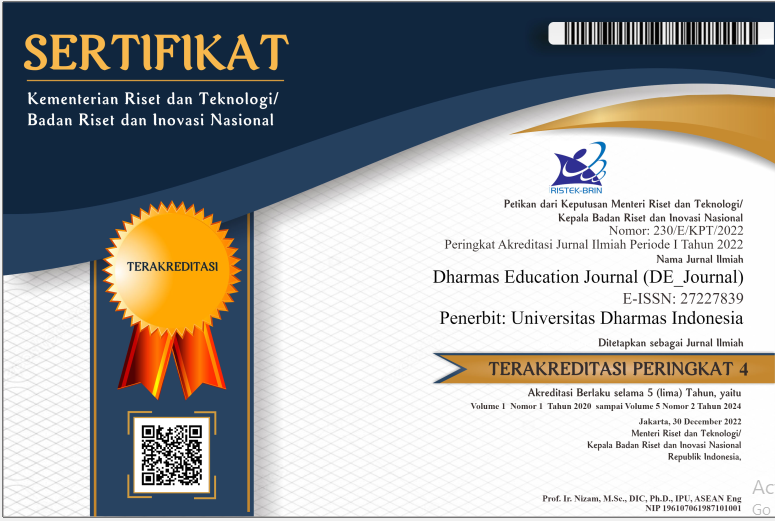DISCOVERING AND PROFICIENCING THE ENGLISH PRONUNCIATION ERRORS
DOI:
https://doi.org/10.56667/de_journal.v4i1.1354Keywords:
Pronunciation errors, ELSA Speak Application, Phonological interference, Non-Native-SoundAbstract
By using the results from the ELSA Speak application, the pronunciation skills of second-year English majors at Universitas HKBP Nommensen Medan were examined. The ELSA Speak Application was utilized to determine the kinds of pronunciation faults made by second-year students at the English Department of FKIP Universitas HKBP Nommensen Medan. This study used a descriptive qualitative research design. The ELSA Speak Application and documentation were used to collect data from students' pronunciation diagnoses. Twenty students were selected as the sample, with the population of the study consisting of the students in the English Department at FKIP Universitas HKBP Nommensen Medan. The following are the conclusions: The majority of the sample found that they would "try again" and "almost correct”. Most of the ‘try again’ categories occurred when students pronounced words in which the sounds were not familiar in the student’s native language which is Bahasa Indonesia, such as /tʃ/. The other words with the ‘try again’ category are found when students pronounce words with subtle sounds and are called because the sound produced is close to a predictable sound so it can be concluded that every word can be understood such as /ŋ/, /v/. The other category of ‘almost correct’ is found in the lateral consonant /l/ and consonant cluster /ft/.
Downloads
References
Afrizal, M. (2015). A Classroom Action Research: Improving Speaking Skills Through Information Gap Activities. English Education Journal, 6(3), 342–355.
Chotimah, C., & Astiyandha, T. (2022). Improving Students’ Vocabulary Knowledge Through Race To The Board Game For Esp (English For Specific Purposes). Lingua, 18(2), 241–251. Https://Doi.Org/10.34005/Lingua.V18i2.2264
Dalle, A. (2019). The Implementation Of Serial Image Media In Learning German Writing Skills To Students Of German Language Education Fbs Unm. Proceedings Of The Seventh International Conference On Languages And Arts (Icla 2018), 404–408. Https://Doi.Org/10.2991/Icla-18.2019.67
Derakhshan, A., & Khatir, E. D. (2015). The Effects Of Using Games On English Vocabulary Learning. Journal Of Applied Linguistics And Language Research, 2(3), 39–47.
Dewi, D. R. (2021). The Effectiveness Of Talking Stick Learning Strategy In Speaking Skills Of Recount Text: A Pre-Experimental Research At Second Grade Students Of Mts Tanwirut Tholibin Lamongan. Universitas Islam Negeri Maulana Malik Ibrahim.
Fauziyah, N. L., Widodo, J. P., & Yappi, S. N. (2022). The Use Of ‘Canva For Education’and The Students’ Perceptions Of Its Effectiveness In The Writing Procedure Text. Budapest International Research And Critics Institute-Journal (Birci-Journal), 5(1). Https://Doi.Org/Https://Doi.Org/10.33258/Birci.V5i1.4359
Febriyanto, B., & Yanto, A. (2019). The Effectiveness Of Photo Story In Multiliteracies Learning Towards Narrative Writing Skills Of Fifth Grade Elementary School Students. Al Ibtida: Jurnal Pendidikan Guru Mi, 6(2), 191. Https://Doi.Org/10.24235/Al.Ibtida.Snj.V6i2.4943
Gilakjani, A. P., & Sabouri, N. B. (2016). Why Is English Pronunciation Ignored By Efl Teachers In Their Classes. International Journal Of English Linguistics, 6(6), 195. Https://Doi.Org/Https://Doi.Org/10.15294/Jne.V6i2.25594
Guskaroska, A. (2019). Asr As A Tool For Providing Feedback For Vowel Pronunciation Practice. Iowa State University.
Herodotou, C. (2018). Young Children And Tablets: A Systematic Review Of Effects On Learning And Development. Journal Of Computer Assisted Learning, 34(1), 1–9. Https://Doi.Org/10.1111/Jcal.12220
Ho, P. V. P., Thien, N. M., An, N. T. M., & Vy, N. N. H. (2020). The Effects Of Using Games On Efl Students’ Speaking Performances. International Journal Of English Linguistics, 10(1), 183–193.
Imran, M. C. (2022). Applying Hemingway App To Enhance Students’ Writing Skill. Edulec: Education, Language And Culture Journal, 2(2), 180–185. Https://Doi.Org/Https://Doi.Org/10.56314/Edulec.V2i2.67
Ismayanti, E., & Kholiq, A. (2020). An Analysis Of Students’ Difficulties In Writing Descriptive Text. E-Link Journal, 7(1), 10. Https://Doi.Org/10.30736/Ej.V7i1.260
Khasawneh, M. A. S., & Al-Rub, M. O. A. (2020). Development Of Reading Comprehension Skills Among The Students Of Learning Disabilities. Universal Journal Of Educational Research, 8(11), 5335–5341.
Künzel, S. R., Sekhon, J. S., Bickel, P. J., & Yu, B. (2019). Metalearners For Estimating Heterogeneous Treatment Effects Using Machine Learning. Proceedings Of The National Academy Of Sciences, 116(10), 4156–4165. Https://Doi.Org/10.1073/Pnas.1804597116
Meinawati, E., Purwaningrum, P. W., Setianingrum, H. W., Alawiyah, S., Nurmalia, L., Dewi, N., Sri Sulistyawati, M. E., & Lestari, V. L. (2021). Students’ Metacognitive Strategy Pattern In English Academic Writing Learning Using Zoom. Al-Ishlah: Jurnal Pendidikan, 13(1), 610–616. Https://Doi.Org/10.35445/Alishlah.V13i1.477
Nair, A., Gupta, A., Dalal, M., & Levine, S. (2020). Awac: Accelerating Online Reinforcement Learning With Offline Datasets. Arxiv Preprint Arxiv:2006.09359. Https://Doi.Org/Https://Doi.Org/10.48550/Arxiv.2006.09359
Purnamasari, A. (2018). What Efl Learners Say About Youtube Use To Improve Pronunciation In A Blended Learning Environment. Jet (Journal Of English Teaching), 4(3), 205–215.
Rahmadani, F., Pammu, A., & Nasmilah, N. (2021). The Use Of Board Race Games Toward The Improvement Of Students Vocabulary’s Memorization At The First Year Students Of English Education Department At Uin Alauddin Makassar. Jurnal Ilmu Budaya, 9(1), 204–211. Https://Doi.Org/Https://Doi.Org/10.34050/Jib.V9i1.12620
Reyes-Chua, E., & Lidawan, M. W. (2019). Games As Effective Language Classroom Strategies: A Perspective From English Major Students. European Journal Of Foreign Language Teaching. Https://Doi.Org/Http://Dx.Doi.Org/10.46827/Ejfl.V0i0.2366
Sari, A. S. P., & Sembiring, R. K. B. (2019). Improving Students’speaking Skill Through The Combination Of Presentation, Practice, And Production (Ppp) Method And Talking Stick Method. Jurnal Liner (Language Intelligence And Educational Research), 2(3), 68–76.
Sari, N. (2015). Improving Students Speaking Skill Through Talking Stick At Tenth Grade Ipa 1 Sman 1 Bangkinang Kota. Jurnal Lppm Universitas Pahlawan Tuanku Tambusai, 1(2), 1–14.
Tasmin, Y. (2016). Improving Students’speaking Skill By Using Talking Stick At The Eight Grade Of Smp Negeri 2 Malangke Barat. The State Islamic Institute.
Wardana, A. K., Miftah, M. Z., & Mirza, A. A. (2022). Assessing Students’writing Ability In A Narrative Text. Project (Professional Journal Of English Education), 5(4), 766–771. Https://Doi.Org/Http://Dx.Doi.Org/10.22460/Project.V5i4.P766-771
Yunita, W. (2016). Best Practice In Teaching English Grammar To University Students: Deductive, Inductive, Or Combination Of Both? Proceedings Of Iselt Fbs Universitas Negeri Padang, 4(2), 435–443.
Downloads
Published
How to Cite
Issue
Section
License
Copyright (c) 2024 Dharmas Education Journal (DE_Journal)

This work is licensed under a Creative Commons Attribution-NonCommercial-NoDerivatives 4.0 International License.
Makalah yang disampaikan diasumsikan tidak mengandung bahan propietary yang tidak dilindungi oleh hak paten














